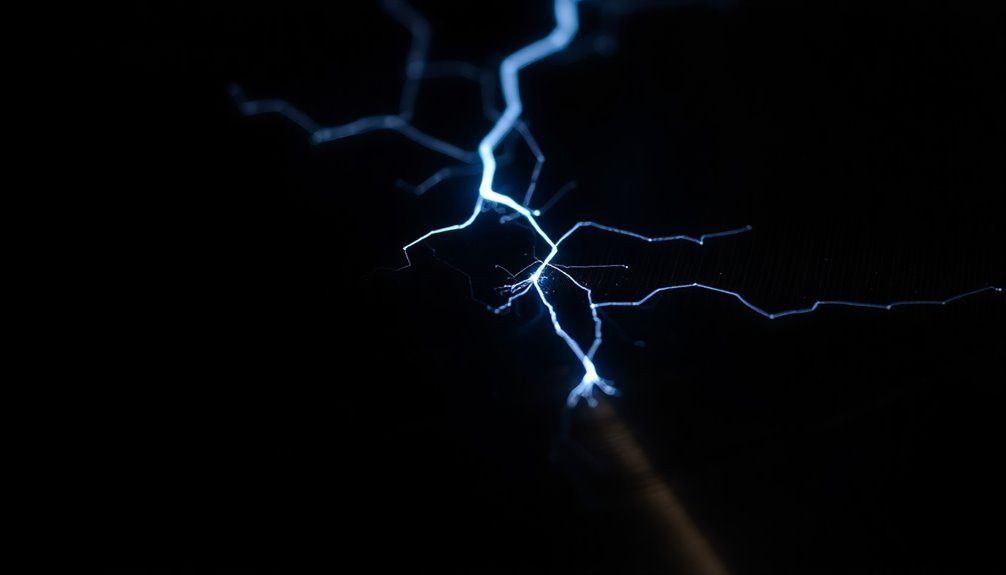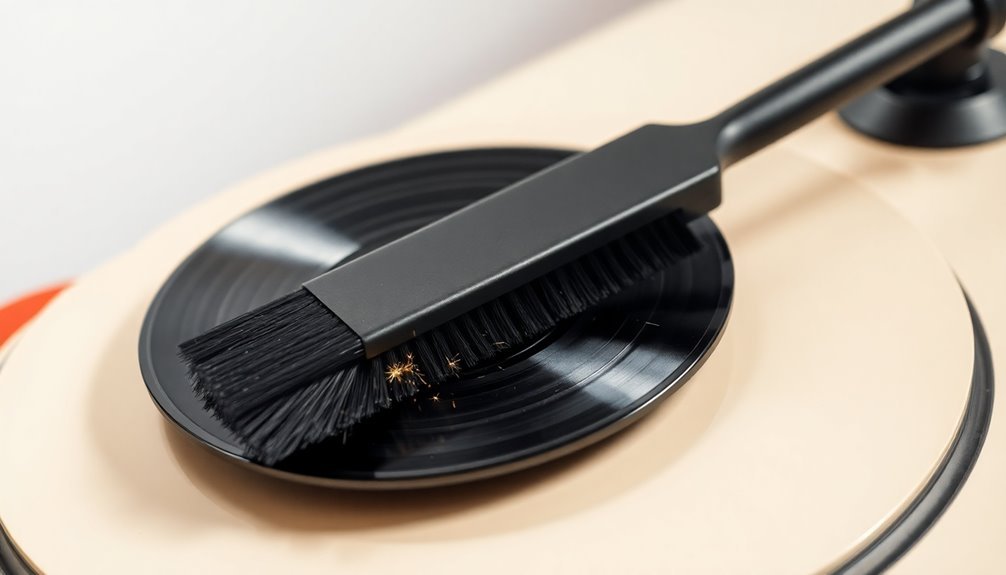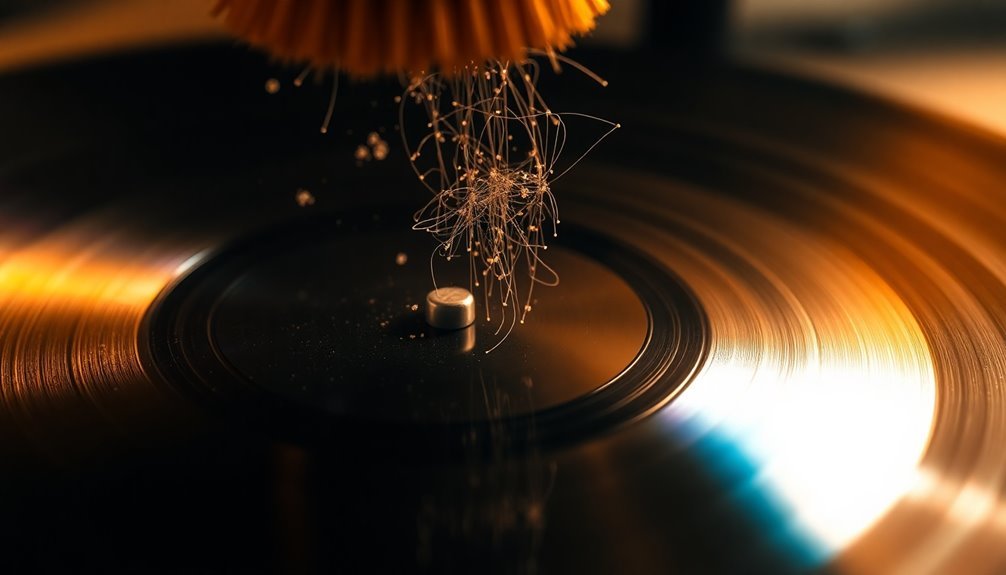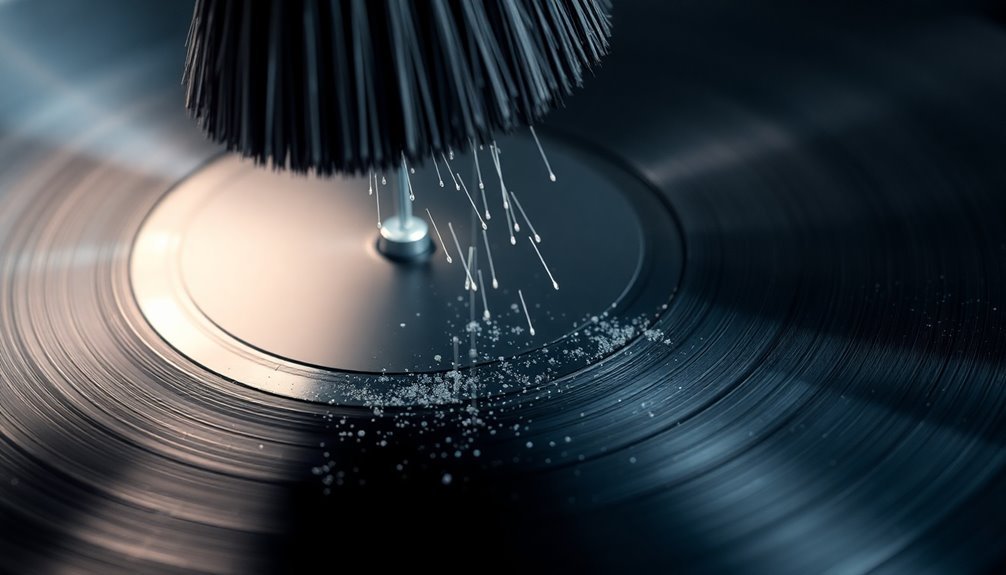Your vinyl records need anti-static treatment because static electricity naturally builds up through handling and playback, attracting dust and causing unwanted pops and crackles. The non-conductive PVC-PVA composition of records makes them especially prone to holding static charges, particularly in dry environments. Static buildup can lead to micro-scratches and long-term physical damage as dust particles get dragged across the surface by your stylus. Using anti-static products like specialized brushes, sprays, and sleeves helps protect your records from these damaging effects. Understanding proper static prevention techniques can substantially extend the life of your precious vinyl collection.
Understanding Static Electricity on Records

The presence of static electricity on vinyl records poses a significant challenge for music enthusiasts and collectors. When you handle or play your records, static electricity builds up through the triboelectric effect, where electrons transfer between surfaces.
Your vinyl records are particularly vulnerable to this phenomenon due to their non-conductive properties and the spinning motion during playback. Dry air environments significantly increase the risk of static buildup.
You'll notice that static electricity creates an imbalance of electric charges on your record's surface, causing it to attract dust and debris. This attraction isn't just a cosmetic issue – it directly impacts your listening experience by creating unwanted noise and interference during playback.
The problem becomes more complex when you consider that environmental factors like heat, UV light, and air pollution can generate negatively charged compounds, further contributing to static buildup.
While record manufacturers add special compounds to vinyl mixtures to help distribute and neutralize charges, you'll often need additional measures to combat static effectively.
The good news is that maintaining proper humidity levels in your listening space can help balance these charges and reduce electrostatic discharges, making your vinyl listening experience more enjoyable.
Common Static Buildup Sources
You'll notice static electricity building up when you handle your vinyl records, as the friction between your hands and the record surface creates an electrical charge.
Your record's exposure to dry environments can worsen static issues, while proper humidity levels help minimize the buildup.
The material of your turntable's platter mat can either contribute to or help prevent static charges, making it essential to choose anti-static materials for your setup. Regularly using carbon fiber brushes on your records helps neutralize static charges while removing dust and debris from the grooves.
Record Handling Friction
Static electricity frequently builds up on vinyl records through everyday handling and interaction with various materials. When you handle your records, the friction between your hands and the vinyl surface creates an electron transfer that generates static charges.
The diamond stylus tip adds to static buildup during playback due to its non-conductive properties. This process intensifies when you slide records in and out of their paper sleeves, as the contact between different materials promotes static buildup.
You'll find that even the basic act of playing your records contributes to static accumulation. As your stylus tracks through the grooves and the record rotates on the turntable, these movements generate additional static charges.
The problem becomes more pronounced with thicker, purer vinyl pressings, which are particularly susceptible to static retention due to their non-conductive PVC-PVA composition.
Your everyday movements around your turntable setup can also impact static levels. When you walk across carpeted floors near your audio equipment, you're creating static electricity that can transfer to your records.
This environmental static, combined with direct handling friction, creates a continuous cycle of static buildup that you'll need to address through proper anti-static treatment and handling techniques.
Environmental Humidity Impact
Humidity levels play a crucial role in managing static electricity on your vinyl records. In low-humidity environments, you'll notice increased static buildup, making your records more susceptible to attracting dust and dirt. This is particularly problematic during winter months when indoor air tends to be drier, causing more friction between your records and their sleeves. Using desiccants in storage areas helps maintain optimal moisture control and prevents excess humidity damage.
While high humidity can help dissipate static charges due to water's conductive properties, maintaining balanced levels is vital. Too much moisture can lead to other problems, such as warping and mold growth. You'll want to maintain humidity levels between 30-50% for ideal record care.
To effectively manage static buildup through humidity control, consider these key strategies:
- Install a humidifier in your record storage area during dry seasons
- Use a hygrometer to monitor humidity levels consistently
- Store records in a finished basement or climate-controlled room
For the best protection of your vinyl collection, maintain a stable environment with temperatures between 50-70°F (10-21°C). You can also use desiccants or silica gel packs to help regulate moisture levels in your storage area, ensuring your records remain static-free and well-preserved.
Platter Material Interaction
Beyond environmental factors, your turntable's components directly influence static electricity generation on vinyl records. The platter material and mat you choose can substantially impact static buildup during playback. While felt and acrylic mats are common, they're notorious for generating static electricity through friction with your records. Incorrect humidity levels in your listening space can intensify static accumulation.
Your vinyl records themselves contribute to the issue, especially if they're made from higher-quality, purer vinyl. Notably, records pressed on recycled vinyl may actually accumulate less static than premium pressings.
The interaction between your record and turntable components creates multiple opportunities for static generation, including friction from the rotating platter and rubber belt against the plinth.
You'll find that cork and leather-like mats offer better alternatives for reducing static buildup. These materials, especially when paired with conductive mats grounded through the turntable bearing, can help discharge unwanted static electricity.
When handling your records, you'll generate less static by using anti-static inner sleeves and carbon fiber brushes. Remember that proper grounding of your turntable setup is essential for minimizing static-related issues that can affect your cartridge's performance and overall playback quality.
Damage Caused by Static

Static buildup on your vinyl records can gradually deteriorate the surface through micro-scratches and increased dust accumulation, leading to permanent physical damage.
You'll notice the impact of static during playback through unwanted pops, crackles, and inconsistent speeds that diminish your listening experience.
These issues become more pronounced in low-humidity environments, where static charges build up more readily and attract even more harmful particles to your record's surface. Using polyethylene lined sleeves can significantly reduce static electricity and protect your records from this type of damage.
Physical Record Deterioration
Although vinyl records are durable media, they're highly susceptible to damage from static electricity buildup. When static charges accumulate on your records, they attract dust, debris, and cellulose fibers from damaged sleeves. These particles become trapped in the record's grooves, creating serious problems during playback.
The physical deterioration of your vinyl records occurs through several mechanisms, particularly during playback when the stylus encounters trapped debris. With pressure reaching up to 20,000 PSI, the stylus can grind these contaminants into the vinyl, causing permanent damage to the grooves. Using a carbon fiber brush regularly can help prevent this type of damage by removing static and debris before playback.
This deterioration is intensified by routine handling and environmental factors:
- Friction from removing and replacing records in sleeves generates additional static charge
- Dry air conditions substantially increase static electricity buildup
- Record rotation on the platter contributes to ongoing static accumulation
You'll notice this damage manifesting as surface noise, pops, and clicks during playback. The combination of static electricity and physical wear creates a destructive cycle – static attracts debris, debris causes wear, and wear makes the record more susceptible to static buildup and further contamination.
Playback Quality Issues
The presence of static electricity directly impacts your record's playback quality in several measurable ways. When static builds up on your vinyl's surface, it creates an electrical charge that actively attracts dust and debris into the record grooves. Dry environments make static buildup significantly worse, as low humidity allows charges to accumulate more easily. You'll hear this contamination as unwanted pops and crackles during playback, substantially diminishing your listening experience.
Your turntable's components can worsen this issue. The rubber belt and certain materials in your player might generate additional static electricity, while improper grounding can fail to dissipate existing charges.
As your stylus travels through the grooves, it grinds these attracted particles into the vinyl surface, creating micro-scratches that you can't see but will definitely hear.
Static discharge into your cartridge produces those distinct snaps and pops you're hearing, and it can even affect your record's playback speed. The vinyl material itself contributes to this problem by naturally accumulating static charge.
You'll need proper anti-static treatment – using tools like anti-static brushes, Zerostat guns, or cleaning machines – to protect your records and maintain superior sound quality during playback.
Environmental Impact Factors
Over time, environmental conditions play a crucial role in how static electricity damages your vinyl records. In low humidity environments, you'll notice increased static buildup, which attracts dust and pollutants to your records' surfaces.
When combined with extreme temperatures and UV light exposure, these conditions accelerate the breakdown of the vinyl material, particularly PVC compounds.
The environmental impact of static-damaged records extends beyond just playback quality. When vinyl degrades due to static-related wear, it can release harmful chemicals into the environment, including:
- Lead and cadmium that leech into soil and groundwater when records are discarded
- Toxic PVC compounds that break down and contribute to environmental pollution
- Microplastic particles that enter ecosystems as the vinyl deteriorates
You'll need to take into account that static-damaged records require more frequent cleaning and maintenance, which often involves chemical cleaning solutions. This increased maintenance not only shortens your records' lifespan but also contributes to greater environmental waste.
The static problem becomes particularly concerning when you're storing records long-term, as continuous exposure to static electricity can permanently damage both the vinyl material and its chemical composition.
Anti-Static Cleaning Methods
Maintaining vinyl records in pristine condition comes down to mastering both wet and dry cleaning methods.
For wet cleaning, you'll want to use a solution of 10-15% isopropyl alcohol mixed with distilled water. Avoid using detergents or surfactants, as they can leave harmful residue in your record grooves.
Always follow up with two separate distilled water rinses to guarantee thorough cleaning.
For dry cleaning, you'll need a carbon fiber brush to combat static electricity. Use it before each play, making sure to clean the brush itself first to prevent debris transfer. When brushing, move gently across the record's surface to remove dust and neutralize static charges.
You can enhance your anti-static efforts by controlling room humidity between 40-50%, using anti-static inner sleeves, and replacing felt mats with cork or acrylic alternatives.
Remember that vinyl's PVC material naturally attracts static, especially in colored records that lack black carbon content. To minimize this effect, always handle your records by their edges and consider using an anti-static gun for particularly troublesome static buildup.
These combined methods will help keep your vinyl collection static-free and sounding its best.
Tools for Static Prevention

Effective static prevention for vinyl records requires a specific set of tools designed to combat electrical charges. You'll find several specialized instruments that work together to maintain a static-free environment for your vinyl collection.
Anti-static brushes featuring carbon fibers are your first line of defense, effectively neutralizing charges while removing dust from micro grooves.
You'll want to complement these brushes with record cleaning solutions that provide deep cleaning and prevent future static buildup. For storage, anti-static sleeves create an essential barrier against static electricity while protecting your records from environmental contaminants.
Here's what you'll need for a complete static prevention toolkit:
- An anti-static gun like the Milty Zerostat 3, which emits ions to neutralize static charges before and during playback
- Quality anti-static brushes, such as the AudioQuest Record Brush, for regular maintenance and dust removal
- Specialized record cleaning solutions paired with anti-static sleeves for ideal long-term protection
These tools work most effectively when used together as part of your regular vinyl maintenance routine. You'll notice substantially reduced static interference and improved sound quality when you incorporate these prevention methods consistently.
Environmental Factors Affecting Static
Throughout your vinyl collection's life, environmental factors play a crucial role in static buildup and management. The most important factor you'll need to monitor is humidity, as dry environments substantially increase static electricity. You'll want to maintain humidity levels between 40% and 50% to minimize static issues, which you can achieve by using a humidifier in your listening space.
Temperature and air quality also affect your records' static charge. High temperatures can increase static buildup, while air pollution can create negatively charged compounds on your vinyl's surface. UV light exposure can break down the vinyl material, making it more susceptible to static charges.
These factors combine to attract dust and debris to your records, potentially degrading sound quality over time.
To protect your collection, you'll need to control these environmental factors actively. Store your records in anti-static sleeves and keep them in a controlled environment. Don't forget that proper handling matters too – always grip records by their edges to minimize contact and static transfer.
Regular cleaning using appropriate anti-static tools will help remove accumulated charges and prevent long-term damage to both your records and playback equipment.
Record Storage Solutions

Now that you understand how environmental factors affect static, proper storage solutions become your next line of defense. You'll want to focus on storage units that help maintain ideal temperature and humidity levels while protecting your records from dust accumulation, which can increase static buildup.
For effective static prevention through storage, consider these essential features:
- Vertical storage units that keep records upright at 90 degrees to prevent warping and static-attracting surface contact
- Storage solutions with dust protection features, such as cabinet doors or protective covers
- Units that allow proper air circulation to maintain consistent humidity levels around 35-40%
When choosing your storage solution, you'll find options ranging from affordable Kallax shelves to custom-built cabinets. Multi-tier storage units can accommodate larger collections while maintaining proper spacing between records.
If you're dealing with space constraints, consider collapsible crates or rolling storage units that offer flexibility without compromising protection. Remember to select materials that don't generate additional static – wooden units often perform better than plastic or acrylic alternatives in this regard.
For best results, combine your storage solution with proper inner sleeves and handle records by their edges using anti-static gloves.
Essential Anti-Static Products
You'll need several key tools to keep your vinyl records free from static electricity and maintain optimal playback quality.
Modern anti-static solutions include specialized sprays like AMD Record Cleaner and Pure Vinyl Mist, high-quality brushes such as the Furutech ASB-1, and protective accessories like Nagaoka N-102 antistatic sleeves.
Replacing standard felt mats with cork or leather alternatives, along with using carbon fiber brushes and proper cleaning products, will substantially reduce static buildup and protect your valuable collection.
Top Record Cleaning Tools
When maintaining your vinyl collection, selecting the right anti-static cleaning tools makes a significant difference in preserving sound quality and record longevity.
Electronic suction machines and vacuum-based cleaners represent the most thorough cleaning options, effectively removing deep-seated dirt while reducing static buildup. These machines often feature eco-friendly cleaning solutions and built-in tanks for continuous operation.
For regular maintenance, you'll want to think about these essential tools:
- Carbon-fiber brushes with anti-static properties that safely remove surface dust without scratching
- Specialized cleaning solutions designed specifically for vinyl, avoiding harmful ingredients that could leave residue
- High-quality anti-static velvet brushes paired with polyethylene sleeves for storage
You'll achieve the best results by implementing a consistent cleaning routine using these tools properly. Remember to use gentle circular motions and avoid applying excessive pressure.
It's essential to maintain your cleaning tools by storing them properly and keeping them dust-free. For maximum protection against static buildup, keep your listening room's relative humidity above 35% and think about investing in professional-grade products like the Milty Zerostat 3 or Furutech Destat 3.
Must-Have Protection Accessories
Protecting vinyl records from static electricity requires a carefully chosen set of essential accessories. You'll need to start with a quality carbon fiber brush, like the Mobile Fidelity Sound Lab or AudioQuest models, which effectively neutralize static charges while removing dust particles from your vinyl's surface.
For storage, you'll want to invest in anti-static inner sleeves made from polyethylene (PE) or rice paper/Mylar combinations. These materials offer superior protection against static buildup while keeping your records dust-free. Avoid PVC sleeves, as they can create static issues over time.
You should also consider specialized anti-static tools like the Milty Zerostat 3 or Furutech Destat 3 guns, which emit ions to neutralize static charges.
A record weight or mat can help dissipate static electricity during playback. To maintain ideal conditions, you'll need to keep your listening room's humidity above 35%, possibly using a humidifier during dry seasons.
Remember to handle your records properly by touching only the edges and label areas. Store them in high-quality polyethylene inner sleeves, and maintain a regular cleaning routine to prevent static buildup that can attract dust and affect sound quality.
Proper Handling Techniques

Proper handling of vinyl records consistently makes the difference between maintaining their quality and causing permanent damage. When you're handling your records, always grip them by their edges and label area to prevent transferring oils and debris onto the playing surface. This simple technique helps minimize static buildup and protects the record's delicate grooves from contamination.
To maintain your vinyl's pristine condition, follow these essential handling practices:
- Never touch the playing surface with your bare hands – use record-handling gloves or clean, dry cloths for additional protection.
- Keep records in a vertical position during handling to prevent dust and debris from falling onto the surface. This is contrary to the suggestion of keeping them horizontal, as vertical positioning is recommended to avoid dust and debris.
- Always return records to their protective anti-static sleeves immediately after use.
You'll want to make certain your records are stored properly after handling them. Place them in polyethylene-lined sleeves rather than standard paper ones, as these provide superior protection against static electricity.
Keep your collection in a clean, controlled environment with moderate humidity levels to further reduce static buildup. The ideal temperature for LP storage is between 60 and 70 degrees Fahrenheit, while the humidity should stay between 40 percent and 50 percent.
If you're serious about preservation, consider investing in specialized record storage solutions that keep your vinyl collection upright and protected.
Record Maintenance Best Practices
Regular maintenance routines extend your vinyl records' lifespan far beyond basic handling practices. You'll need to clean your records before and after each playing session using a carbon fiber brush to remove dust and reduce static buildup. For deeper cleaning, use a mixture of specialized record cleaning fluid and distilled water with a microfiber cloth.
| Maintenance Task | Frequency | Tools Needed |
|---|---|---|
| Basic Cleaning | Before/After Play | Carbon Fiber Brush |
| Deep Cleaning | Monthly | Cleaning Fluid, Microfiber Cloth |
| Stylus Care | Weekly | Stylus Cleaner |
| Storage Check | Quarterly | Humidity Monitor |
Store your records in a controlled environment with temperatures between 60-75°F and relative humidity of 30-50%. You'll want to keep them away from direct sunlight and use proper storage units like crates or shelves. For heavily soiled records, consider specialized cleaning techniques such as wood glue treatment or using a melamine pad with distilled water. Don't use household vacuum cleaners or tap water, as these can damage your vinyl. Instead, invest in a record-specific vacuum system for professional-grade cleaning when needed. Remember to clean your cleaning tools regularly to maintain their effectiveness.
Professional Anti-Static Treatments

With advancements in vinyl care technology, professional anti-static treatments have become essential tools for serious record collectors. You'll find various professional-grade solutions designed specifically to combat static electricity, from specialized carbon fiber brushes to advanced ionic guns like the Milty Zerostat III.
For the best results, you'll want to take into account these professional anti-static treatments:
- Quaternary ammonium compounds, similar to those used in electronics clean rooms, provide effective static reduction
- Professional cleaning machines that offer thorough cleaning and static removal in one process
- Anti-static sleeves, like Nagaoka N-102, that prevent static buildup during storage
When implementing professional treatments, it's vital to maintain proper humidity levels in your listening environment and handle records correctly by their edges.
You'll achieve the best results by combining regular maintenance with deep cleaning solutions. Products like Gruv Glide offer long-lasting protection, while cork or leather platter mats can substantially reduce static generation during playback.
Remember to avoid general-purpose cleaning products that aren't specifically designed for vinyl records, as they can actually increase static buildup and potentially damage your collection.
Frequently Asked Questions
Can Old Records Be Permanently Damaged by Years of Static Buildup?
Yes, your old records can be permanently damaged by static buildup, as it grinds accumulated dirt into the vinyl grooves over time, causing irreversible wear, sound distortion, and potential damage to your turntable's stylus.
Will Using Anti-Static Treatments Affect the Original Sound Quality?
No, you won't lose your record's original sound quality with proper anti-static treatments. They'll actually improve your listening experience by reducing unwanted pops and crackles while ensuring more consistent playback speeds.
How Often Should Anti-Static Treatments Be Applied to Frequently Played Records?
You'll need to use an anti-static brush before each play, perform quick cleanings regularly, and do deep cleanings every 15-20 plays. Store your records in anti-static sleeves between uses for best results.
Does Static Buildup Vary Between Different Vinyl Record Manufacturers?
Yes, you'll notice static buildup varies substantially between manufacturers based on their material composition, pressing quality, and anti-static treatments. Higher-quality pressings with carbon-enriched PVC typically accumulate less static than budget pressings.
Can Static Electricity Damage the Turntable's Stylus or Cartridge Components?
While static won't directly damage your stylus or cartridge, it can harm playback quality by attracting dust and debris. You'll need to clean components more frequently, but proper grounding and anti-static treatments prevent these issues.
In Summary
You'll need anti-static treatment for your vinyl records to prevent dust attraction, crackling sounds, and potential damage to the grooves. By regularly using anti-static brushes, specialized cleaning solutions, and proper handling techniques, you're protecting your collection from static electricity buildup. Don't skip this essential maintenance step – it'll help preserve your records' sound quality and extend their lifespan for years of enjoyable listening.





Leave a Reply